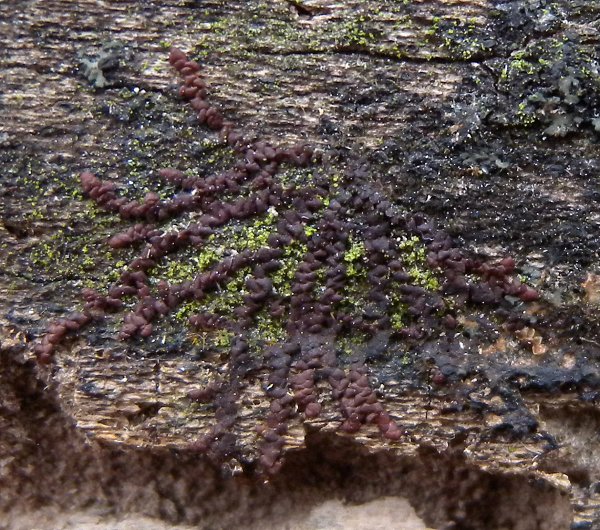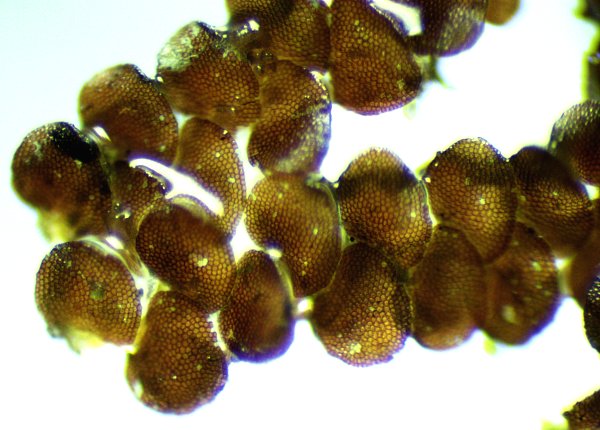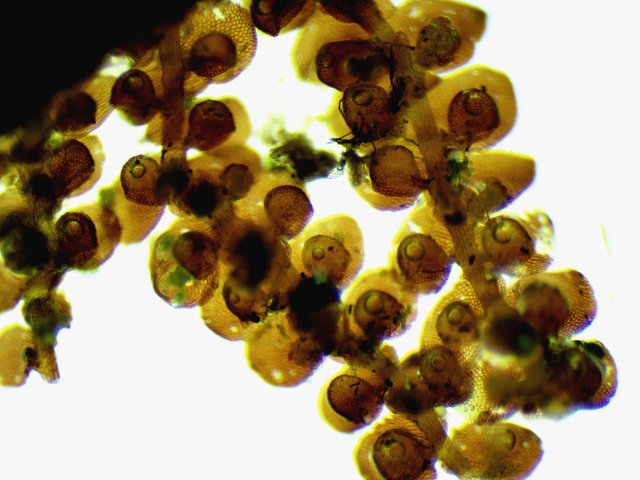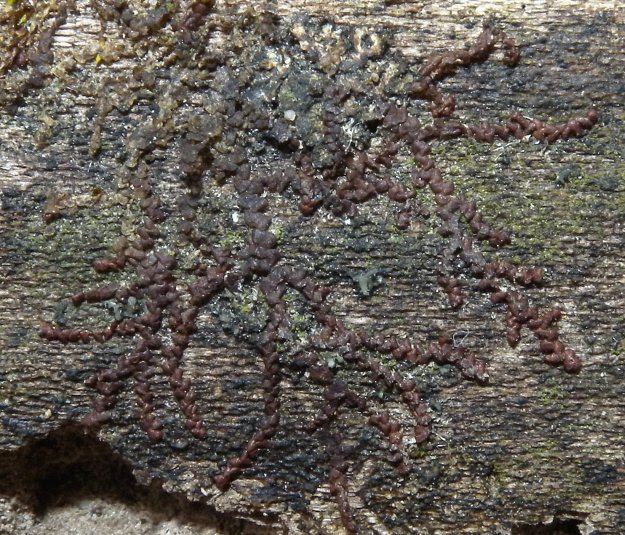
Individual lower lobes are about 0.2 mm. long and 0.2 mm. across; they are folded into helmet-shaped pockets that are somewhat flattened. The rounded sides of each helmet-shaped pocket are folded and closed, while its truncate bottom is open. Each pair of upper and lower lobes are connected to each other by a short narrow stalk. Pairs of alternate leaves are accompanied by solitary underleaves that are appressed against the lower sides of the stems. These underleaves are about 0.2 mm. long and 0.15 mm. across; they are divided into 2 lanceolate lobes. Each pair of these lobes extends to about one-third of the length of an underleaf; the lateral margins of the underleaf are toothless or nearly so. Directly across from the base of each underleaf, there is a tiny spike, only 2-3 cells across at its base, that is linear in shape. New York Scalewort is dioecious, forming male and female reproductive organs on different plants. Male plants produce their reproductive organs on short lateral branches that have several pairs of leaf-like bracts. These bracts resemble the leaves, except they are somewhat smaller in size. Female plants produce their reproductive organs at the tips of stems. The female reproductive organs are contained in bud-like perianths (one perianth per stem tip); preceding and partly surrounding the base of each perianth, there are about 3 pairs of bracts.

Each perianth is about 1 mm. long, obovoid in shape, 3-angled, and erect; it terminates abruptly in a short slender beak. The perianth is keeled along its angles; these keels are relatively smooth or only slightly roughened. The bracts preceding the perianth resemble highly modified leaves; they are up to 0.8 mm. long, 0.45 mm. across, and unlobed to irregularly lobed. After fertilization occurs, spore-bearing capsules on stalks develop during the spring for about 2 weeks. The stalks are white, terete, translucent, hairless, and ascending to erect, while the small capsules are broadly ovoid to globoid, brown to black, and hairless. At maturity, individual capsules divide into 4 parts, releasing their spores to the wind. Fibrous rhizoids develop from the axils of the underleaves along each leafy stem; they anchor the plant to the underlying surface. This leafy liverwort can reproduce asexually by forming gemmae (miniature buds) along the margins of its leaves. New plants can develop when the gemmae become detached from the leaves.
Cultivation: The preference is partial sun to medium shade and moist to dry-mesic conditions. This leafy liverwort normally colonizes tree bark. It has greater tolerance to sunlight and dry heat than most leafy liverworts, but it is intolerant of competition from other plants.

Range & Habitat: The native New York Scalewort (Frullania eboracensis) is occasional in most areas of Illinois (see Distribution Map). This leafy liverwort undoubtedly occurs in additional counties than what has been indicated, but it is easy to overlook because of its small size. New York Scalewort is widely distributed in eastern North America and adjacent areas of southern Canada. Habitats include bark of trees on rocky bluffs, bark of trees along wooded slopes, bark of trees in upland and lowland woodlands, bark of trees along streams and ponds, bark of trees in swamps, exposed roots of trees in woodlands, logs of fallen trees in woodlands, bark of trees in cemeteries, and planks of wooden fences in damp shaded places. This leafy liverwort has been found primarily on the bark of deciduous trees, including oak, maple, ash, elm, hackberry, cottonwood, beech, and musclewood. It has also been found on the bark of Eastern Red Cedar (Juniperus virginiana). Usually, it is found on the trunks of trees, rather than branches or exposed roots. Older mature trees are preferred over young trees. This leafy liverwort prefers natural areas with trees, although sometimes it is found in more developed areas where mature trees occur.
Faunal Associations: Rotifers sometimes inhabit the helmet-shaped lower lobes of leaves. It is unclear if this causes any benefit or harm to the plant (Puterbaugh et al., 2004). This leafy liverwort is used to a minor extent in the construction of nests by Prothonotary Warblers (Blem & Blem, 1994).

Photographic Location: A fallen log near a pool of water in Busey Woods at Urbana, Illinois. Close-up photographs were taken indoors using a microscope.
Comments: New York Scalewort (Frullania eboracensis) is the most common scalewort (Frullania sp.) in Illinois; the remaining species of scalewort are uncommon to rare within the state. The common name derives from an old Latin word (Eboracum) for York, England. But this name actually refers to the state of New York, where this leafy liverwort was first collected. Another name that could be applied to this plant is Common Scalewort. Sometimes species in this genus are assigned to their own plant family, Frullaniaceae. The structure of the alternate leaves for this group of plants is unusual. The helmet-shaped lower lobes of these leaves have the capacity to store water, enabling these miniature plants to withstand dry spells for a longer period of time. New York Scalewort can be distinguished from other species of scalewort within the state by its small size (leafy shoots only 0.8–1 mm. across), lower leaf lobes that are about as long as they are across, lower leaf lobes that are about one-third to one-half the size of upper leaf lobes, underleaves (0.15 mm. across) that are only a little wider than their stems (0.10 mm. across), underleaves that have toothless or nearly toothless lateral margins, perianths that have smooth to slightly roughened keels along their sides (rather than tuberculate keels), and leaf cell walls that are swollen at intervals.